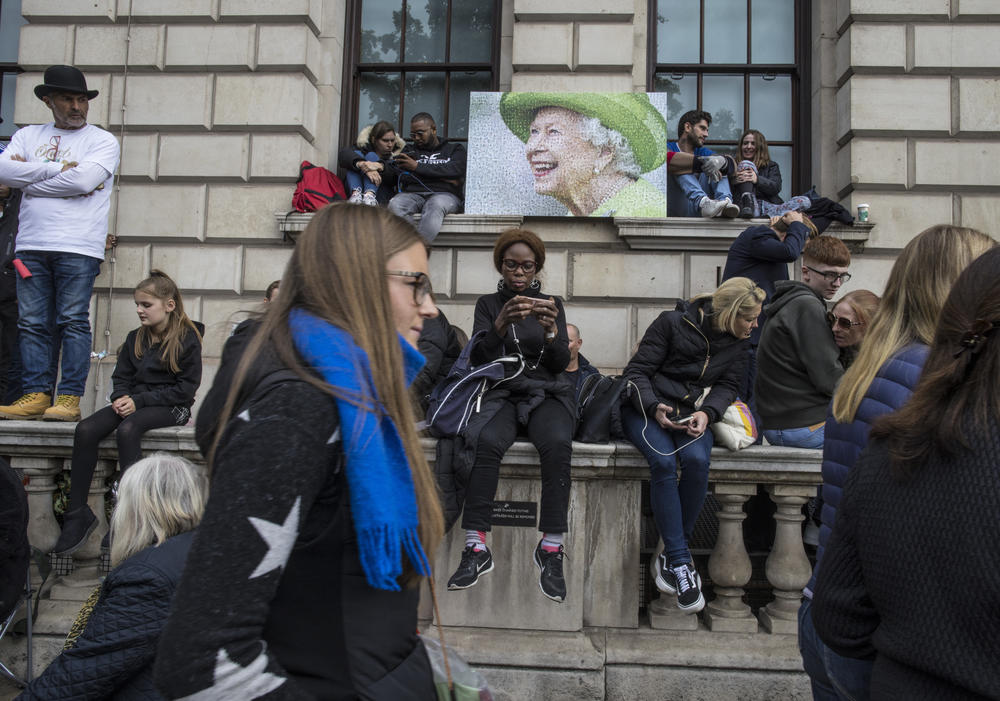Section Branding
Header Content
Outside the funeral, a community united in awe of the queen
Primary Content
LONDON — Queen Elizabeth's funeral was by all accounts a somber and stately affair. But to many in the crowd outside Westminster Abbey, it was made joyous by the company of others and a sense that they had done all they could to thank the late monarch.
A sizable crowd — though smaller than many said they had expected — set up camp and staked out spots along the area to say a final farewell to the queen and see the pageantry with their own eyes.
Those who hadn't slept there overnight showed up early in the morning with cameras and coffee cups in hand. Some were wearing T-shirts honoring the queen, several were dressed up in suits, dresses and hats.
It was every person for themselves when it came to getting a good view; people defended their spots along the sidewalk and atop concrete walls with ferocity. Other than that, it was a community united — in their awe of the queen's service, in the elaborate send-off or both.
Many said that, besides catching a glimpse of the queen's casket during the procession, the highlight of their experience was the sense of unity and sharing the moment with people who were all there for the same reason, regardless of their other differences.
Sally Parr, who watched the proceedings from a rolling office chair she'd gotten from her son's nearby flat, said the best thing about her day was talking to people and making new friends even if she never saw them again.
"It was just a really pleasant, nice, everybody looking out for everybody, friendly, happy atmosphere, except when the queen went past when we all got very solemn," she added.
Veronica Knibbs-Hughes said being there in person gave her a chance to show her appreciation for the queen, as well as meet people across race, class and culture lines. That act of participation made her feel included, she said.
"Sometimes you do feel a bit marginalized, a bit on the edge, and it's nice to be included," she added. "You feel uplifted, [it] helps your spirits, helps your growth and it ricochets. It helps society as a whole."
She hopes that sense of unity will last far for more than just one day, or 10.
Even so, some people in the crowd were bigger fans of the monarchy than others. Two art students, Ruth Meynell and Tulla Burnet were there to check it out, represent their families and get stories to tell, but described themselves as "not really monarchists" because of some of the harm it had done in the past.
Still, they seemed to admire the queen's decades of service and concluded that "no one's perfect."
Chris Imafidon, who has written books about the queen, says he met her regularly through his work with an education organization and praised her for inviting underprivileged children to the annual Commonwealth Service. He said her attention inspired them and gave them a sense of importance.
Imafidon added that he could tell that the queen personally cared about equality, but also acknowledged the "nasty, ugly" parts of the institution she represented. She admitted that too, he said, pointing to her support for African nations' independence as an example.
"I'm not looking at the monarch, I'm looking at the mother," said Imafidon, who was wearing a face mask and holding an umbrella with the queen's image.
The crowd didn't really thin after the funeral began, with many people staying put and pulling out their phones to livestream coverage of the service. Toward the end of the ceremony an announcer called for two minutes of silence, and the crowd complied willingly before breaking into "God Save the King."
People craned their necks to see the queen's casket and members of the royal family leaving Westminster Abbey, and most only began to pack up when the procession was safely out of view.
The observers, weary from a long day of mourning — and for many, more than a week — seemed to be chatty and in good spirits as they headed out. Some had to travel home, others planned to visit other tributes in the city or spend time with family.
And even though the ongoing military movements and closed barricades prevented the crowd from leaving quickly, many people took it in stride. They unpacked their folding chairs, took out their snacks and even prepared cups of tea, already eager to start reminiscing on a day they're sure to never forget.
Copyright 2022 NPR. To see more, visit https://www.npr.org.



